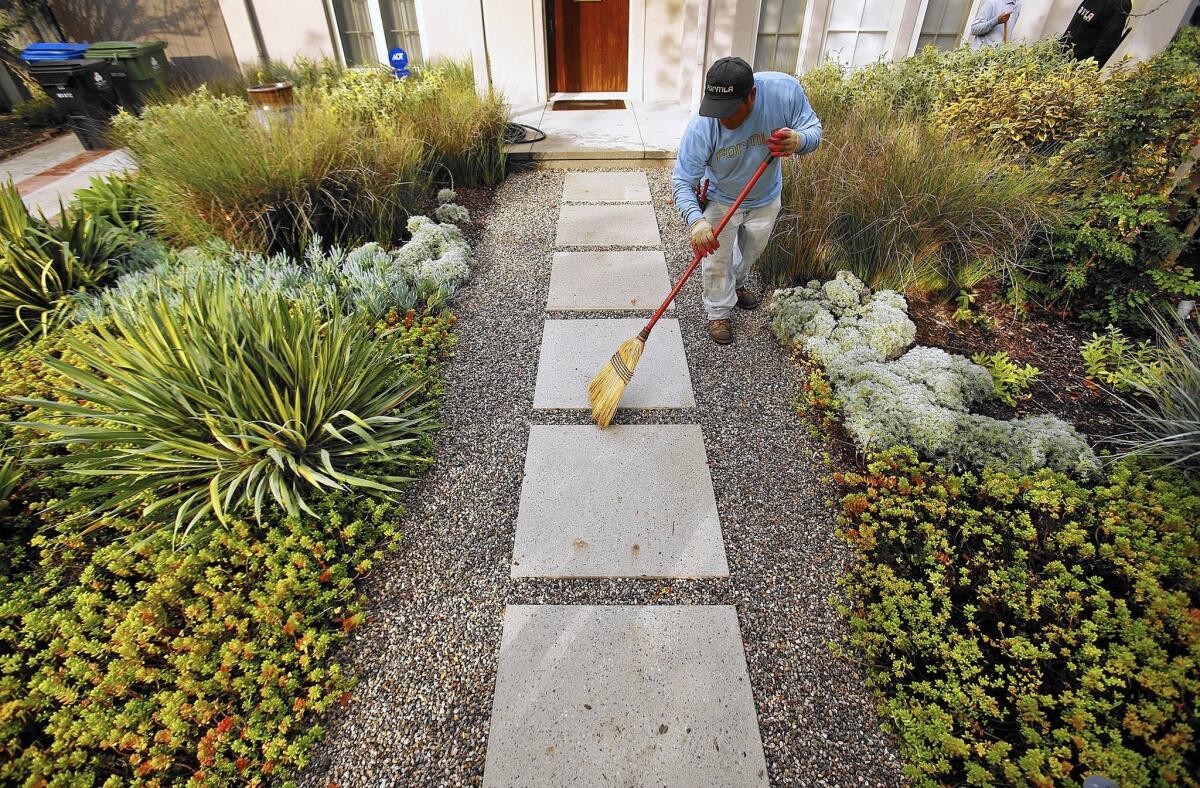Gardeners, nurseries struggle to adapt as drought cuts their business

Wet weather kept Alberto Ortega from working most of last week â and he couldnât have been more pleased.
âThis rain is a blessing I was beginning to think Iâd never see,â the gardener said.
In four decades of tending peopleâs yards, this year has been Ortegaâs roughest: Clients put off landscaping projects, scaled back his duties or simply let their yards go altogether, costing him thousands of dollars.
As one of Californiaâs worst droughts continues, gardeners across the region have been faced with a choice: Become more water-savvy or risk being left behind.
Higher water rates and more municipal restrictions on usage are bound to force the entire industry to transform, said Bob Muir, spokesman for the Los Angeles Metropolitan Water District.
âThe change will be gradual, but soon, youâre going to see more and more people transition their yards,â Muir said. âAnd those gardeners who donât adapt will see their opportunities become more sparse.â
Itâs tough to say how long it will take to phase out the ideal of a lush, thirsty garden; water policy experts say it could be decades.
Ortega, 60, already feels like heâs playing catch-up.
In the evening, after catering to clients across Los Angeles, he comes home to study books on drought-tolerant gardening. He scours the Internet for tutorials. Sometimes, his Ortega Gardening Service clients lead the way and introduce him to hardy plants heâs never heard of.
âIt hurts to go back after so many years, but I have to,â Ortega said. âLater on, we may find this is a blessing in disguise.â
Rudolph Zuzow of Z Greens is facing a similar learning curve.
Just a few years ago, his planting staples were water-hungry fruit trees and flowers such as pansies and snapdragons.
Now, having sought advice from drought-friendly nurseries, heâs pushing plants such as coyote bush.
That is, if he can find them.
The gardener of 32 years, whose business is based in La Crescenta, said tracking down the natives requested by clients can be tricky.
âThese things take time to grow,â Zuzow said. âAnd nurseries just canât seem to grow them fast enough.â
Many donât carry them at all.
The directory of reliable nurseries and growers Zuzow used to keep â outfits carrying lush greens, azaleas and camellias â is not so handy any more. Those business are facing their own struggles.
Among them is Shima Nursery in Rosemead.
The wholesale supplier of trees and ornamentals has seen business slide in the last year, owner Frank Tsushima said. His out-of-state accounts have been affected by economic issues, and his California sales have taken a hit due to the drought.
âEveryone wants drought-tolerant, but we donât carry those,â Tsushima said.
At 80 years old, he has no plans to update his stock. It would take too long to grow the seedlings, too much effort to relearn all the plant names and growing habits.
At this point, Tsushima is more interested in selling his shop, though heâs not sure heâd find a buyer. âItâs hard,â he said. âWho would buy a nursery that sells a product thatâs not so much in demand?â
The changed reality means water agencies will need to step in and provide significantly more training and classes â in English and Spanish â for gardeners, landscapers and growers, said Ellen Hanak, a water expert at the nonpartisan Public Policy Institute of California.
âFrom the point of a healthy economy, you need these shifts to happen,â she said. âBut these workers will need support in order to transition.â
At the Theodore Payne Foundation, a nonprofit nursery specializing in native plants, an outreach plan is underway. The nursery soon will open an education center catering to industry professionals as well as public agencies. There will be courses in plant selection, design and irrigation.
âPeople are having to retrain and polish their skills, and this will give them that opportunity,â executive director Kitty Connolly said.
The Sun Valley-based organization has been touting native plants since 1960. In the last three years, it has seen a significant rise in sales and visits from people looking to learn about more drought-resistant options.
âWeâve added more plants, staffed up some and done what we can to anticipate and keep up with demand,â Connolly said.
A few miles away in Tujunga, the folks at FormLA, a landscaping firm with a drought-friendly focus, are doing the same.
When the business launched 20 years ago, it was nearly impossible to get people to listen to its native-plants message. âI wouldnât even touch the subject by phone,â said president Cassy Aoyagi. âI would meet in person and try to sneak it into the design.â
Eventually, she hired a public relations consultant to better explain the goal of her business. Drought-resistant requests now come in without much prompting.
In the last six months, Aoyagi said, more than 60 people have called, hoping to take advantage of rebates offered by water agencies. To get homeowners to remove their water-intensive lawns, the Los Angeles Department of Water and Power will pay $3.75 a square foot for the first 1,500 square feet of grass residents replace with drought-resistant plants.
Callers are eager to make the switch, but often they find they still canât afford it, Aoyagi said. So she tries to find alternative resources for them.
âThese are people who are really trying to make a difference,â Aoyagi said. âThey should be able to get their slice of nature too.â
Twitter: @LATbermudez
More to Read
Sign up for Essential California
The most important California stories and recommendations in your inbox every morning.
You may occasionally receive promotional content from the Los Angeles Times.











